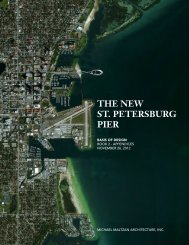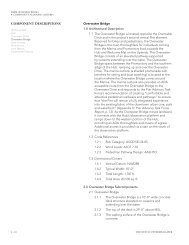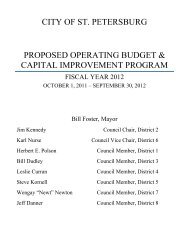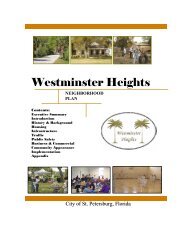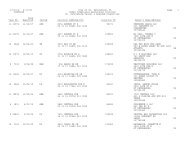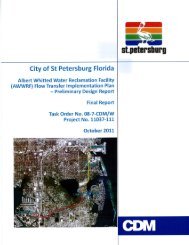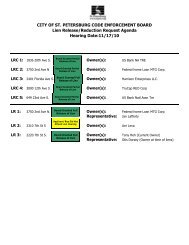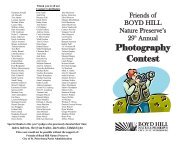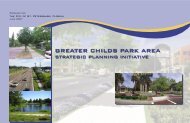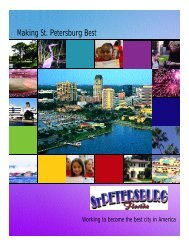Book 1 - City of St. Petersburg
Book 1 - City of St. Petersburg
Book 1 - City of St. Petersburg
Create successful ePaper yourself
Turn your PDF publications into a flip-book with our unique Google optimized e-Paper software.
BASIS OF DESIGN BOOK 1<br />
3 GENERAL PLANNING CRITERIA<br />
PERMITTING AND<br />
DEMOLITION (continued)<br />
During construction, a detailed stormwater management plan<br />
will be implemented incorporating best practices including silt<br />
fencing and filter media for storm drains for maintaining quality<br />
<strong>of</strong> the storm water effluent reaching the bay.<br />
Water Dependent Use<br />
The existing Pier includes retail spaces for souvenir shops, bait<br />
and tackle, clothing, and restaurants. Most <strong>of</strong> the existing retail<br />
will be relocated from the Pier to the landside. Enclosed spaces<br />
remaining on the Pier are water dependent uses including food<br />
service areas for visitors, restrooms, elevators and utility rooms,<br />
and management service <strong>of</strong>fices for the marina.<br />
Mitigation<br />
The new Pier footprint and design features result in a net<br />
environmental benefit. Environmental benefits include reduced<br />
pollutant loading from vehicles by eliminating passenger vehicle<br />
access on the new Pier, reduced overwater footprint to reduce<br />
bay bottom shading including 75% reducing in shading in<br />
seagrass habitat areas, and a reduced number <strong>of</strong> piles impacting<br />
the bay bottom. The new Pier has approximately 1/3 the number<br />
<strong>of</strong> support piles compared to the existing Pier. The shoreline<br />
revetment at the Albert Whitted Airport stabilizes the existing<br />
shoreline/seawall, does not impact existing seagrass areas, and<br />
will reduce sediment run<strong>of</strong>f from the upland during storm events.<br />
Marina Environmental Considerations<br />
The existing Pier boat slips support docking <strong>of</strong> up to 24 transient<br />
boats. The ERP application included a 24 slip transient Marina.<br />
The proposed Pier now includes a non-motorized Blue Ways<br />
marina, further reducing the potential pollutant loading and<br />
improving the net benefit to the environment. If the final<br />
design maintains the non-motorized marina, the reduction in<br />
the environmental impact will not require a modification to the<br />
permit. The marina floating docks will be designed with wave<br />
attenuation to provide protection from the north, west, and<br />
south directions.<br />
Analysis <strong>of</strong> marina flushing shows that tidal circulation in the<br />
proposed transient marina reduces a conservative tracer to less<br />
than 10% residual concentration in 0.17 to 0.45 days, meeting the<br />
state guideline <strong>of</strong> 10% residual concentration after 96 hours.<br />
Underwater Feature Environmental Considerations<br />
The planned Underwater Feature, located in 12 to 14-ft. water<br />
depths, consists <strong>of</strong> concrete reef structures mounted to the top<br />
<strong>of</strong> piles. The reef structures are located in the intertidal zone and<br />
are intended to provide habitat for fish and other sea life. The<br />
Underwater Feature <strong>of</strong>fers potential educational opportunities<br />
including educational signs and a small amphitheater for docent<br />
or teacher presentations.<br />
3 - 140<br />
THE NEW ST. PETERSBURG PIER




